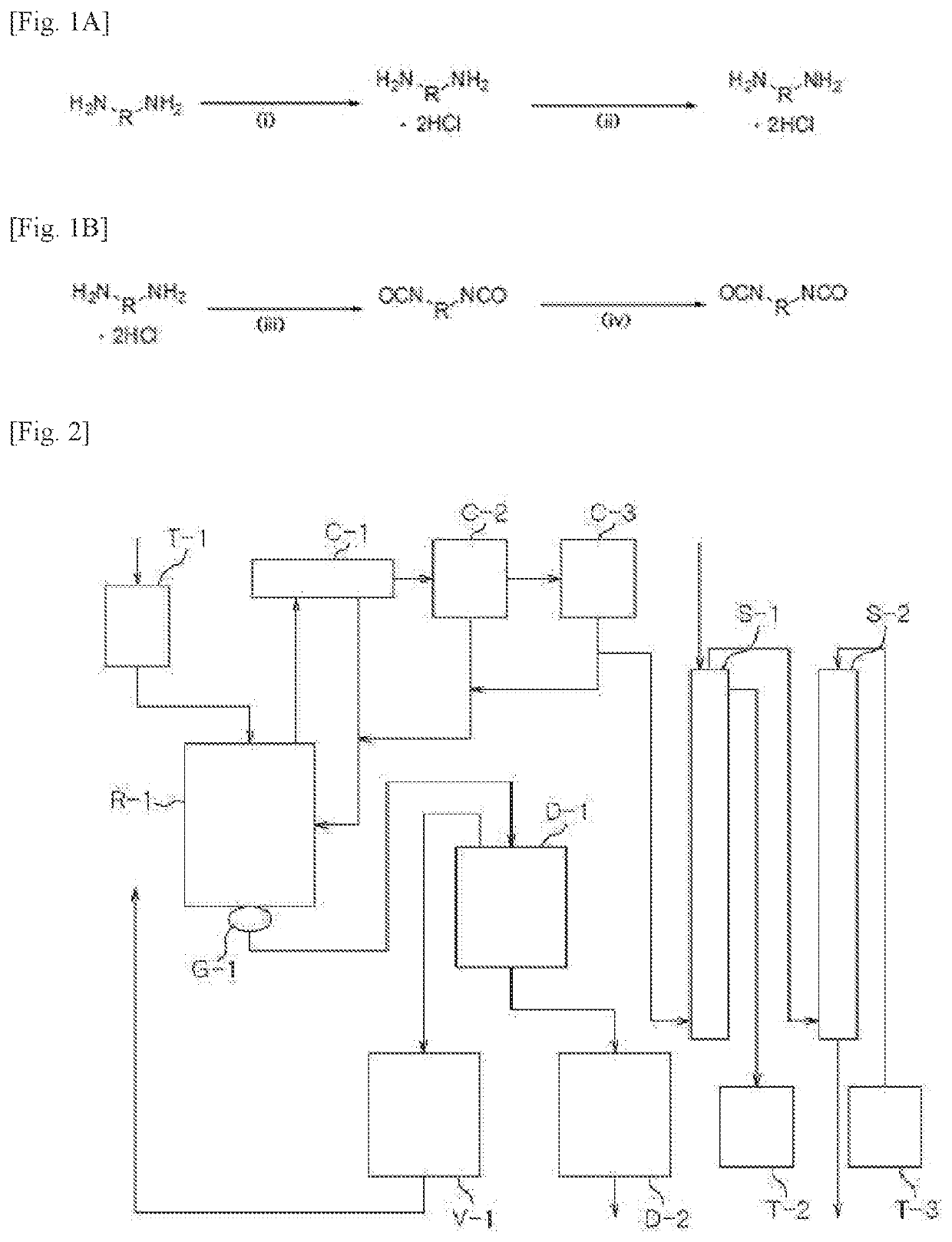Diisocyanate composition, preparation method thereof and optical material using same
a technology of diisocyanate and composition, which is applied in the direction of isocyanic acid derivative purification/separation, instruments, optical elements, etc., can solve the problems of difficult to satisfy, limit in achieving satisfactory optical characteristics, and deterioration of impact resistance, so as to improve optical characteristics and improve quality. , the effect of high quality
- Summary
- Abstract
- Description
- Claims
- Application Information
AI Technical Summary
Benefits of technology
Problems solved by technology
Method used
Image
Examples
example 1-1
[0212]
[0213]A 5-liter, 4-neck reactor was charged with 1009.4 g (9.46 moles) of an aqueous solution of 35% hydrochloric acid, followed by lowering the internal temperature of the reactor to 15° with stirring. While the temperature of the reactor was maintained at lower than 60° C., 600.0 g (4.4 moles) of metaxylylenediamine (m-XDA) was introduced for 1 hour. Upon completion of the introduction, the internal temperature of the reactor was lowered to 10° C., and it was stirred for 1 hour. Thereafter, 1,320 g of tetrahydrofuran as an organic solvent was introduced, and the internal temperature of the reactor was lowered to −5° C., followed by stirring for 1 hour. Upon completion of the reaction, it was subjected to vacuum filtration using a filter, and the filtered tetrahydrofuran was recovered for reuse. The recovery rate of the tetrahydrofuran was 82%. Upon the vacuum filtration, a metaxylylenediamine (m-XDA) hydrochloride composition was obtained. In order to remove the residual org...
examples 1-2 to 1-7
[0218]A m-XDI composition and an optical lens were obtained in the same manner as in Example 1-1, except that the timing and concentration of 3-methylbenzyl isocyanate introduced were adjusted as shown in Table 1 below.
example 2-1
[0243]
[0244]A 5-liter, 4-neck reactor was charged with 1009.4 g (9.46 moles) of an aqueous solution of 35% hydrochloric acid, followed by lowering the internal temperature of the reactor to 15° C. with stirring. While the temperature of the reactor was maintained at lower than 60° C., 600.0 g (4.4 moles) of metaxylylenediamine (m-XDA) was introduced for 1 hour. Upon completion of the introduction, the internal temperature of the reactor was lowered to 10° C., and it was stirred for 1 hour. Thereafter, 1,320 g of tetrahydrofuran as an organic solvent was introduced, and the internal temperature of the reactor was lowered to −5° C., followed by stirring for 1 hour. Upon completion of the reaction, it was subjected to vacuum filtration using a filter, and the filtered tetrahydrofuran was recovered for reuse. The recovery rate of the tetrahydrofuran was 82%. Upon the vacuum filtration, a metaxylylenediamine (m-XDA) hydrochloride composition was obtained. In order to remove the residual ...
PUM
| Property | Measurement | Unit |
|---|---|---|
| temperature | aaaaa | aaaaa |
| temperature | aaaaa | aaaaa |
| transmittance | aaaaa | aaaaa |
Abstract
Description
Claims
Application Information
 Login to View More
Login to View More - R&D
- Intellectual Property
- Life Sciences
- Materials
- Tech Scout
- Unparalleled Data Quality
- Higher Quality Content
- 60% Fewer Hallucinations
Browse by: Latest US Patents, China's latest patents, Technical Efficacy Thesaurus, Application Domain, Technology Topic, Popular Technical Reports.
© 2025 PatSnap. All rights reserved.Legal|Privacy policy|Modern Slavery Act Transparency Statement|Sitemap|About US| Contact US: help@patsnap.com



